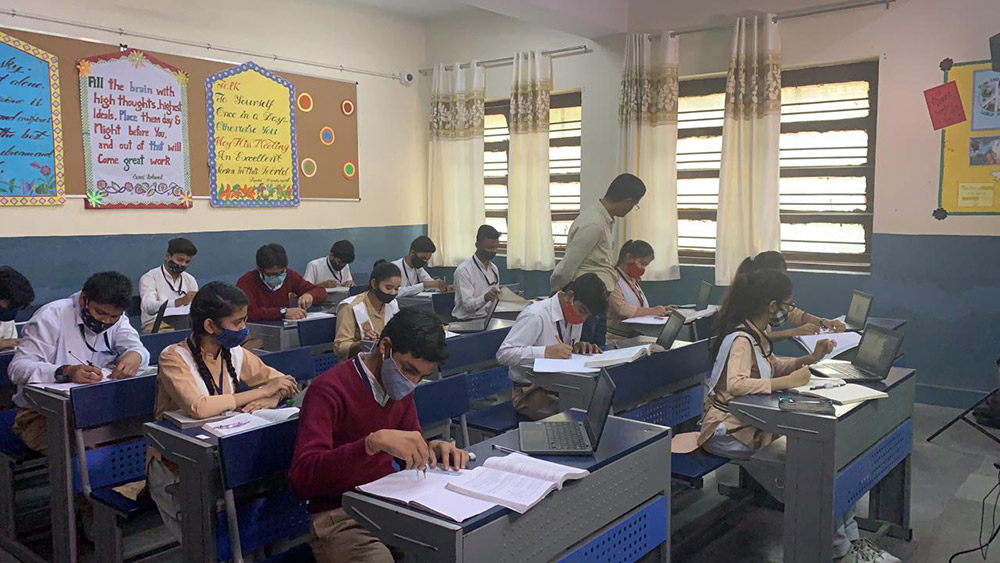Blogs
Teaching-learning in a post pandemic world: Identifying problem areas

It was only till a year ago that education seemed to be the same as it had been for decades - crammed classrooms, unappreciated teachers, and one size fits all content. But, in the midst of all of that, there was still the fun of going to school, of meeting friends and colleagues, and learning through interaction. In a crowded classroom, teachers still managed to teach and keep children engaged, albeit with varying impact and success, and teaching-learning continued through verbal and non-verbal communication.
Cut to the post pandemic world, all of that seems to have disappeared suddenly. Students have ceased to be physical entities and reduced to faceless, static tiles on the computer screen. In a digital reality necessitated by circumstances, teachers and students have started missing the physical interaction that a school facilitates. My seven-year-old daughter’s craving to go back to school is a reliable testimony to that.
But it seems, the times have something else in store for us - online learning is here to stay. It is, at the same time, also certain, that online mode of teaching alone will not be sufficient, let alone be an efficacious way of learning. We are therefore, bound to see more and more of a blended pedagogical approach in times to come.
With so many digital tools available, technology pundits have often argued, the 'learning crisis' would be solved in a jiffy. But, the ground reality seems to be different as there’s less coffee and more froth. I, like many others, believe that it was never a 'learning crisis'. It was more of a 'teaching crisis' or an 'implementation crisis'. And, this can get deeper, as we rapidly move to an online, albeit blended, teaching-learning world. I can see that happening almost everyday during my daughter’s ongoing online classes. Teachers are now faced with an altogether new challenge. How to keep the learner engaged and motivated? How to ensure that meaningful learning continues to happen? Looking through the prism of Clayton Christensen’s Jobs-To-Be-Done (JBTD) framework, a teacher now needs to 'hire' new instructional practices so that:
- She can engage and challenge more of her students in a way that’s manageable
- She can replace a broken instructional model and reach each student
- She can facilitate student agency in a blended environment
Often, there appears to be a gap between what teachers wish to achieve with online technologies and what students expect the teaching to be. Trying to deploy the same strategy of a traditional classroom teaching in an online environment, the academic community has already started realising, is becoming counter-productive. So, as one develops a digital pedagogy, there are three theories that seem to shed some light on learner behaviour and possible actions when it comes to online teaching and learning:
1. Promoting Dialogue and Interaction :
Michael G. Moore, in his theory of 'transactional distance' (1991) explained that any educational transaction has two components - structure and dialogue. Structure and dialogue are inversely proportional. If structure increases, dialogue decreases. Personalization begins when structure is decreased and dialogue increases. Increasing dialogue, Moore argued, reduced the amount of psychological or transactional distance perceived by the student.
So, how can a teacher do that in an online teaching? Can she create activities, synchronous and asynchronous, to promote interaction and dialogue? Can technology generate such curated online activities, on a need basis, that can come to the aid of the teacher? How do we strengthen the interactions between learner-teacher; learner-content, and learner-learner? These are the crucial considerations for creating a vibrant online teaching-learning environment.
2. Immediacy of Feedback / Benchmarking :
The American psychologist Leon Festinger’s 'Social Comparison Theory' (1954) suggests that our social perceptions are driven by the need to reduce uncertainty. People need to know how they are doing in relation to others who are similar to themselves. If such is the case then it is imperative that in online environments, students will want to benchmark their progress in relation to the rest of the group, as well.
So, how can that be achieved? Regular and timely feedback to students on their progress is just as important in an online environment, if not more so, than it would be in a traditional face-to-face context.
Can we think of providing assessment opportunities for students with timely and relevant feedback in-built into the assessments so that they provide a sense of progress and assuage the anxiety and uncertainty? The feedback loops between learners and teachers could be immediate or phased, but they definitely need to be there.
3. Student Support: Learning Community:
Another proven approach is to ensure that all students receive immediate support they require. Research shows that students require three kinds of support for online learning:
(a) Academic support, which is usually offered by the tutors and experts.
(b) Technical support, which sometimes is of low level and can be addressed through the technology itself.
(c) Emotional and social support, as students may need some encouragement or a sympathetic ear to listen to their concerns. Online communities of learning wherein students within the group help each other in a mutual support system, and provide an informal channel for peer-to-peer learning could be the way forward.
As educationists and technologists continue to develop ed-tech “solutions”, it might be worthwhile to focus on these problems, which are really hankering for a solution. While technology tools are available aplenty, what is genuinely missing is the soul - digital pedagogy and engagement mechanisms for the learners.




